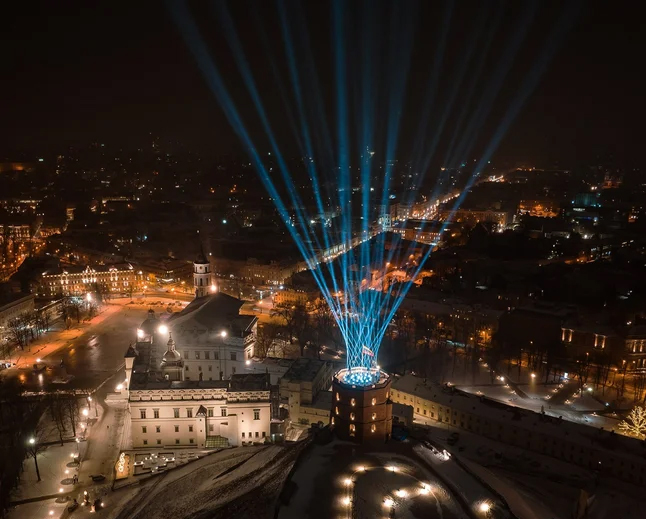Be honest. Do you know where Vilnius is? It’s a question that the people charged with promoting this beautiful and historic city are asking potential visitors. And it seems that far too often the answer is still no.
But why should you know? What is it that makes the capital of Lithuania worthy of your precious travel plans? I was lucky enough to spend a weekend exploring the city and sharing in the celebrations of its 700th anniversary to find out the answer.
Approaching Vilnius from the sky the patchwork of deep green tree plantations and frozen lakes give way to red-roofed houses and spacious gardens. The airport is a ten minute drive from the city centre and the retail parks and industrial units on the outskirts quickly transform into cobbled streets, grand Baroque buildings and winding lanes filled with boutiques, galleries and restaurants.
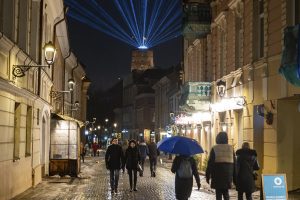
It’s snowing as I go to explore the city after dark and discover Vilnius Light Festival, a series of artistic light installations set against some of the city’s most stunning architecture. Most of the installations are outdoors in the streets, squares and courtyards and while it’s chilly, the snow certainly adds to the drama as the flakes are captured in the colourful lights as they fall. One of my highlights was Flux in the glorious Church of St Catherine, as the spinning rods dance to the beat of the music they illuminate the intricate carvings, altar and vaulted roof to stunning effect.

The morning brings a historic tour of the old town to discover the history of some more of Vilnius’s grand buildings. Our guide Lina is an authority on the city, as well as a talented storyteller. She guides us around St Anne’s Church one of the remaining gothic churches in the city. We explore the glorious Cathedral with its mix of Baroque and Neoclassical architecture. But it is her stories of the Soviet occupation of Lithuania, that saw these beautiful old buildings demoted to warehouses, that really struck a chord. Her recounting of The Baltic Way, a peaceful demonstration in 1989 against Soviet occupation, which saw two million people form a human chain across the Baltic States of Estonia, Latvia and Lithuania connecting their capitals, was particularly moving.
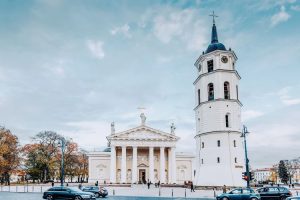
As well as a fascinating ancient and modern history, Vilnius surprised me with the quality of its food and drink. Lunch at Lokys provided the opportunity to try some traditional and modern local food. On the recommendation of a Latvian visitor to the city I plump for boiled potato zeppelins with a game filling. The climate in Lithuania, not a million miles away from that of Scotland, lends itself well to the production of meat and potatoes and this hearty and comforting dish that has been a tradition here for 150 years takes me back to a childhood of scoffing mince and tatties. The minced game in the centre is rich and delicious and is wrapped in shredded potato before being boiled and served up with sour cream and bacon lardons. Healthy, nope. Delicious and warming on a winter’s day. Heck yes!
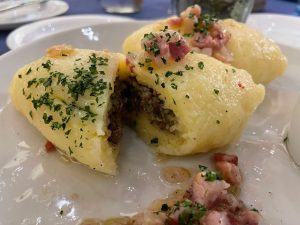
Another vegetable that grows in abundance here is the beetroot, which has spawned the famous pink soup which is made with the colourful vegetable, kefir and milk. Served cold, I’m waiting for summer to sample this refreshing delicacy.
Game is popular in Lithuania and while the opportunity to enjoy venison and even wild boar isn’t uncommon in Scotland, I couldn’t pass up the chance to sample a beaver stew. The meat was not quite as rich as boar and perhaps more akin to venison. I wouldn’t hesitate to recommend it.
Lithuania is also famous for its beer and the choice of local brews is impressive, there’s even a beer museum where you can try many of them under one roof. If you fancy a non-alcoholic tipple I can recommend the sea buckthorn tea. Bright orange and made from the berries of the plant which grows abundantly here it is sweet and sour and pleasantly warming.
Next stop is a real treat for fans of the hit TV show Stranger Things. Lukiskes Prison doubles as the Russian jail where the heroic Hopper finds himself imprisoned for much of season four. For anyone who watched the show you’ll have witnessed how tough life in this prison was for the lovely Hopper, but man eating monsters aside, a real-life spell in Lukiskes was enough to scare the most hardened criminals.
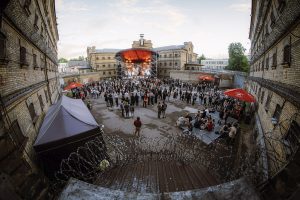
Our tour reveals cramped and cold cells, where prisoners would have spent all but 90 minutes of their day. The remainder being ‘enjoyed’ in outdoor cells with a thick layer of ice on the ground during winter and only a hard wooden bench for comfort. For 150 years the cells hosted political prisoners, exiles and some of Lithuania’s most dangerous criminals behind its high walls and rolls of barbed wire. But today the only prisoner to be found is a life-sized cardboard cut out of President Putin. Operating as a prison until 2019, Lukiskes is now an events venue which houses artists’ studios and even a shiny new sauna in the courtyard.
The chilly weather necessitates a quick stop off at a relatively new addition to Vilnius’s drinks’ scene. Piana Vyshnia is a cool little bar which unusually only serves up the tipple of the same name. This delicious Ukrainian cherry liqueur can be enjoyed cold, but I’d recommend you try it hot. The highlight is definitely the boozy cherries that remain at the bottom of your glass to be enjoyed when you’ve finished your drink.
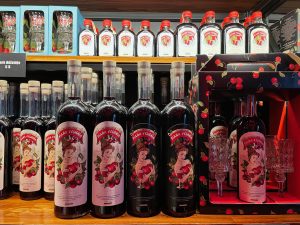
The morning brings some retail therapy and when I say there’s something for everyone I really mean it. There are high end boutiques like Max Mara and Hugo Boss a mere 100 metres from small market stalls selling cosy knitted mittens and socks and a huge range of arts and crafts. I browse until my heart is content before marching up to see the stunning Gate of Dawn, a site of Catholic pilgrimage in Lithuania and part of the defensive fortifications of the city built in the early part of the 14th century.
I’m also curious about The Independent Republic of Uzupis, which our guide Lina had pointed out the day before. Situated on the banks of the River Vilnia, from which the city takes its name, this area became a down-at-heel neighbourhood occupied by crooks and villains during the Soviet occupation. But it now regards itself as an independent district which has become a haven for artists and bohemians and the waterfront properties are becoming more akin to prime real estate. Wandering past galleries and craft shops I reach the statue of the Angel of Uzupis which symbolises the rise of this once-derelict district.

There’s much to occupy history buffs in Vilnius, and I certainly wasn’t disappointed by the stunning architecture of the old town. But it is the modern culture that was a real revelation. The thriving art scene, combined with far too many incredible places to eat and drink to explore in just a weekend, make Vilnius a vibrant and diverse city to visit.
For more information on planning a trip to Vilnius visit govilnius.lt
How to get there:
I flew to Vilnius from Edinburgh airport via Amsterdam on KLM and Air Baltic and home via Zurich with Swiss Air and Edelweiss.
Where to stay:
There’s a wide range of accommodation on offer. I stayed at Artagonist Art Hotel, which is in the heart of the city. This cool hotel boasts lots of incredible original works of art. The welcome is warm and the rooms are spacious and modern. I loved the giant mural and foliage engulfed balconies in the triple height atrium. Be sure to try the curd pancakes which are part of an amazing spread at breakfast, curd is really popular in Lithuania and makes a delicious filling.
Where to eat:
Augustin – Casual dining in this cosy restaurant serving up mainly small sharing plates. There are lots of veggie options here, but they do a mean beef tartare too. Try the oyster mushrooms in batter and the incredible home-made Augustin bread.
Lokys – A great place to check out traditional and modern Lithuanian cuisine. There’s a vast menu full of game meat, forest foods and local delicacies to be enjoyed.
14 Horses – Whether you choose to dine in the bistro, or go all in with the tasting menu (give yourself a few hours as this is an epic event) you’re sure to be treated to lots of local produce. Try the trout eclair with fermented cucumber and the sunflower cake.
TAGS

